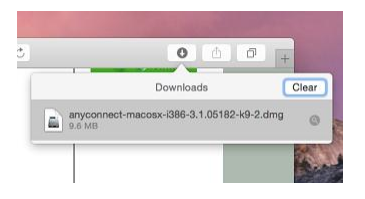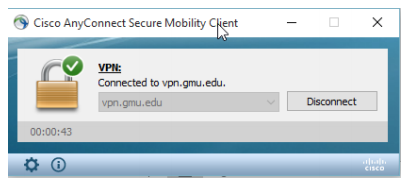Mac users interested in Cisco anyconnect mac 10.6.8 generally download: Cisco AnyConnect Secure Mobility Client 4.7 Make the VPN experience easier and more secure with the enhanced remote access technology of Cisco AnyConnect Secure Mobility Client. Download the VPN AnyConnect client for Intel. Note: Minimum MacOS for this version is 10.13 (only 64-bit is supported from 10.15 and later) Support for 10.13 will end in November; Save the client to your desktop. After the download completes, double-click the anyconnect-macos-4.9.00086-core-vpn-webdeploy-k9.pkg installation file. Mac OS X 10.10.4 and Cisco AnyConnect Are there known issues or changes needed with Mac OS X 10.10.4 and the AnyConnect client? Specifically have upgraded Mac to latest 10.10.4 release and see issues with AnyConnect client 3.1.05170, where the connection fails after authenticating at the command line (or before completing 2FA with the GUI client). The AnyConnect Secure Mobility Client provides a secure connectivity experience across a broad set of PC and mobile devices. As mobile workers roam to different locations, an always-on intelligent VPN enables the AnyConnect Secure Mobility Client to automatically select the optimal network access point and adapt its tunneling protocol to the most efficient method, such as Datagram Transport.
- Cisco Anyconnect Download
- Cisco Anyconnect Download Windows 10
- Cisco Anyconnect Mac Yosemite Download
- Cisco Anyconnect Mac Client Download
- Cisco Anyconnect Mac 10.10 Download Dmg
Access to most active sessions in Cisco dCloud requires a VPN connection between your laptop and the dCloud data center that is hosting your active session.
Use one of the three options below to connect your laptop to an active dCloud session using Cisco AnyConnect VPN Client:
All options are described below in order of recommended use.
Due to differences in operating systems and AnyConnect versions, your screens may differ slightly from those included in the steps below.
Use Cisco AnyConnect Client Already Installed on Your Laptop
If you are logged in to Cisco AnyConnect, please log off before starting this procedure.
To use the Cisco AnyConnect client already installed on your laptop:
- In dCloud, go to My Hub > Sessions, find the active session, and then click View.
- Click Details.
- In the Session Details window, scroll to the AnyConnect Credentials section.
- Start Cisco AnyConnect on your laptop.
- Copy the Host URL from the AnyConnect Credentials, paste it in the URL Connection box in the AnyConnect login window, and then click Connect.
If you get a connection error, remove the “https://” part of the URL and try the connection again.

- Copy a user ID (Users) and the password from the AnyConnect Credentials and then paste each into the Cisco AnyConnect login window.
- Click OK.
- Click Accept on the window confirming your connection.
- When connected to your AnyConnect VPN session, the AnyConnect VPN icon is displayed in the system tray (Windows) or task bar (Mac).
- To view connection details or to disconnect, click the AnyConnect VPN icon and then choose Disconnect.
Download and Install Cisco AnyConnect Client from Cisco.com
If you encounter any issues with this method, please use the method described in the Use the dCloud Browser Based Cisco AnyConnect.
To download and install the Cisco AnyConnect client from Cisco.com:
- Go to the Cisco Support & Downloads page.
- You must be logged in with your Cisco.com credentials.
- You may be prompted to accept or comply with additional terms in order to download the software. Follow the directions in the popup window.
- In the Downloads box, enter anyconnect.
- In the search results, choose the version of AnyConnect you want to install.
- Cisco dCloud recommends installing the latest version of AnyConnect Secure Mobility Client.
- Locate the package you need based on your operating system.
- For Windows users, we recommend choosing Full installation package – Window / Standalone installer (ISO).
- For Mac users, we recommend choosing Full installation package – Mac OS X / Standalone installer (DMG).
- Click Download.
- You may be required to accept or comply with additional terms in order to download the software; follow the directions in the popup windows.
- Review the Cisco End User License Agreement and then click Accept LicenseAgreement.
- Install the AnyConnect software on your laptop.
- In dCloud, go to My Hub > Sessions, find the active session, and then click the View button.
- Click Details.
- In the Session Details window, scroll to the AnyConnect Credentials section.
- The AnyConnect Credentials in your active session are needed to download the software and log in.
- Start Cisco AnyConnect on your laptop.
- Copy the HostURL from the AnyConnect Credentials, paste it in the URL Connection box in the AnyConnect login window, and then click Connect.
If you get a connection error, remove the “https://” part of the URL and try the connection again.
- Copy a user ID (Users) and the Password from the AnyConnect Credentials, paste each into the Cisco AnyConnect login window, and then click OK.

- Click Accept on the window confirming your connection.
- When connected to your AnyConnect VPN session, the AnyConnect VPN icon is displayed in the system tray (Windows) or task bar (Mac).
- To view connection details or to disconnect, click the AnyConnect VPN icon and then choose Disconnect.
Use the dCloud Browser Based Cisco AnyConnect

Due to the Java applet used by this method, you may encounter compatibility issues with your local browser and/or installed version of Java. Use this option only if you cannot install the Cisco AnyConnect VPN Client on your laptop.
To use the dCloud browser based Cisco AnyConnect:
- In dCloud, go to My Hub > Sessions, find the active session, and then click the View button.
- Click Details.
- In the Session Details window, scroll to the AnyConnect Credentials section.
- Scroll down to view the AnyConnect Credentials for your active session, which are needed to download the software and log in.
- Scroll down to view the AnyConnect Credentials for your active session, which are needed to download the software and log in.
- Click the question mark, and then find the section Use the dCloud Browser Based Cisco AnyConnect.
- Click the link next to Click the Host URL to start this option. You are brought to the AnyConnect server address for the dCloud data center hosting your session. For example, the AnyConnect server address for the Americas data center is https://dcloud-rtp-anyconnect.cisco.com.
- Accept any security alerts or certificate warnings.
The SSL VPN Service window opens in a new browser tab (or new window).
- Accept any security alerts or certificate warnings.
- Copy a user ID (Users) and the passwordfrom the AnyConnect Credentials and then paste each into the SSL VPN Service Login window
- Click Login.
If the automatic installation does not start, close and re-open your browser window.
- Follow the on-screen instructions to connect to AnyConnect.
- Accept any security alerts or certification warnings.
- When you have successfully connected to AnyConnect:
- A window displays, similar to below, advising of a successful connection.
- The AnyConnect VPN icon is displayed in the system tray (Windows) or task bar (Mac).
If the automatic installation fails, install AnyConnect manually by following the on-screen instructions.
- To view connection details or to disconnect, click the AnyConnect VPN icon and then choose Disconnect.
Installing the VPN Client
Cisco Anyconnect Download
- Download the AnyConnect VPN client for macOS 11.0 - 10.15 (Big Sur to Catalina) or macOS 10.14 - 10.13 (Mojave to High Sierra).
- In your Downloads folder, double-click the file you just downloaded to open it. An icon will appear on the desktop called AnyConnect, and a separate window will open.
- Double-click on AnyConnect.mpkg to run the installer, then follow the steps to complete the installation. NOTE: We recommend you un-check everything (Web Security, Umbrella, etc) except for the VPN and the Diagnostic and Reporting Tool (DART). This will give you a minimal install. The other features are not supported so there's no need to install them.
- Starting with macOS 10.13 High Sierra: During the installation, you will be prompted to enable the AnyConnect software extension in the System Preferences -> Security & Privacy pane. The requirement to manually enable the software extension is an operating system requirement.
Starting the VPN Client
Cisco Anyconnect Download Windows 10
- In your Applications folder, go to the Cisco folder and double-click the Cisco AnyConnect Secure Mobility Client.
- Enter vpn.uci.edu in the Ready toConnect to field, then press the Connect button.
- Select your desired connection profile from the Group drop-down menu:
- UCIFULL – Route all traffic through the UCI VPN.
- IMPORTANT: Use UCIFULL when accessing Library resources.
- UCI – Route only campus traffic through the UCI VPN. All other traffic goes through your normal Internet provider.
- UCIFULL – Route all traffic through the UCI VPN.
- Enter your UCInetID and password, then click OK.
- A banner window will appear. Click Accept to close that window. You are now connected!
Cisco Anyconnect Mac Yosemite Download
Disconnecting the VPN Client
Cisco Anyconnect Mac Client Download
When you are finished using the VPN, remember to disconnect.
Cisco Anyconnect Mac 10.10 Download Dmg
- Click the AnyConnect client icon located in the menu bar near the top right corner of your screen.
- Select Quit.
